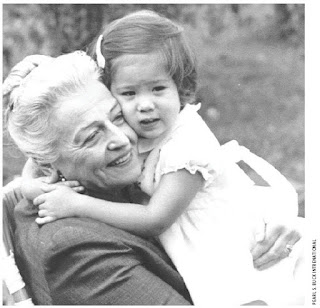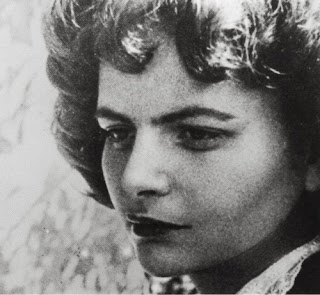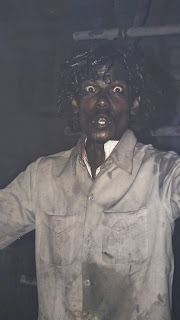 |
| Writer Grace Paley |
American. She’s like an older sister to me. I read her audacious writing, and I think, wow, she was so intrepid! Robert Kaplan posts quotes and excerpts from writers on facebook, and that’s how I discovered her writing. Chance. She didn’t get half the recognition and awards she deserved, and is in danger of slipping into oblivion. Help! Rescue her unique work!
What to read: her short stories. All of them: they're fun and mind blowing and very much grounded in NYC.
Why she should be read: Tone. Freedom of expression. Time capsule. Originality.
 |
| French woman writer Violette Leduc |
2. Violette Leduc (1907-1972)
This French writer was mentored by Simone de Beauvoir. The latter was a good writer too, particularly her memoirs, but not underrated. De Beauvoir, and Sartre too, behaved most shabbily at times toward their intellectual competition. But de Beauvoir paid a publishing house to forward secretly Violette Leduc a monthly allowance that allowed her to write. Most elegant. Leduc’s writing was modern in its rawness and authenticity. Totally underrated.
Why she should be read: she was a groundbreaker, her work is unflinching in describing herself and others. There is no need to make allowance when you read her, as you might for mid 20th century writer.
What to read: La Bâtarde, no doubt. This memoir tells of her origins (she was the illegitimate daughter of a maid and an aristocrat), of her love affairs with both men and women, of her life during WWII when she was a black market operator: fascinating! Raw. Authentic. Compelling.
 |
| Swedish woman writer Selma Lagerloff |
I always feel bad for people who died in the early 1940s: imagine the picture of Europe they took to the grave. She was a lesbian as was Yourcenar. Marriage, and child rearing, had typically not allowed women to develop their creativity. Successful creative women in the 19th century and 20th century were usually not marriedL George Sand, George Eliott, the Brontës, some were even crippled like painter Schjerfbeck.
Lagerloff was the first woman writer to win the Nobel Prize (hum, she was Swedish), but is now mostly overlooked.
Why she should be read: her work is of a bold, romantic streak, without any sentimentality: a treat to devour under or over the covers.
What to read: Difficult to recommend something, as she wrote in a whole range of genders. The Wonderful Adventures of Nils is a great book to read to children. I loved her Löwenskold series, which is more realistic than some of her gothic or fantasy works.
 |
| French woman writer Marguerite Yourcenar. |
Marguerite Yourcenar won a Nobel Prize yet she is not as read as she could be, maybe because work is often historical fiction but she eschews the traps of the genre. She is admired by a number of writers for her rich prose and for the drama of her work.
Why: a beautiful stylist, and a great story teller.
What to read: Memoirs of Hadrian (Hadrian wrote an autobiography that has been lost, Yourcenar imagined what it might have been), Coup de Grâce (romantic novella about a dramatic triangle) is a great book gift for a woman in her twenties.
Anecdotal: She had a 40 year relationship with literary scholar Grace Frick. They lived together on an island in Maine.
5. Jamaica Kincaid: born 1949 in Antigua. Alive and kicking.
 |
| Writer Jamaica Kincaid |
Jamaica Kincaid is a writer who is getting quite a bit of recognition. But that’s not good enough, because she is great, there is not a word that needs to be thrown away in her writing. She will only stop being underrated and scratched from this list when she gets the Nobel Prize.
Why she should be read: there is an undercurrent of passion, in the sense of Christ’s passion, in her work. Her prose is spare and powerful.
What to read: I love The Autobiography of My Mother (great title too), but Lucy is her most famous work.
 |
| Carson McCullers |
She married a man also called McCullers who also wrote and drank. Then they divorced. Then they married again. Without ever having to alter her name in her documents. She lived at a time when a lot of creative people did not live long: Jackson Pollock, James Dean, Marilyn Monroe, Jane Bowles (should she be included in this list?), Albert Camus. She had a funny, sweet face. Her style is supposed to be Southern Gothic. I don’t know, I think she’s just a good writer. Her characters are memorable, they touch the heart without sentimentality. She’s underrated because they don’t read her in high schools when it would be most appropriate content, I rest my case.
Why: great characters that will stay with you. Psychological insight. Depiction of Southern society.
What: Member of the Wedding. The Heart is a Lonely Hunter is awesome too, written when she was 23.
 |
| Chinese American writer Pearl Buck |
She led a fascinating life, being born the child of missionaries in China. She loved China, the Chinese people and peasantry which she described in her works. She was an activist against racism and sexism. The Good Earth was the second-best-selling novel of the 20th century, outsold only by "Gone With the Wind: the two best selling novels are works by women! The people voted!
Why she should be read: great story teller, amazing insights into China at the beginning of the 20th century.
What to read: Any of the Chinese novels, such as The Good Earth. A great read for teenagers too. I positively loved her memoir, Fighting Angel, about her father, a tender and honest portrait of a stiff Baptist missionary with some redemptive traits. Apparently her portray of her mother, The Exile, is also very good.
Anecdotal: when she was old, she got involved with a shady character, some kind of swindler who squandered most of her fortune. A sad and grotesque endgame for a remarkable woman.
 |
| Italian writer Elsa Morante |
You read right, Morante not Ferrante. In my opinion the better writer. A powerhouse of a writer. It’s so inspiring to read explosive works by women who lived when the consensus was that women were weak creatures that could only decorate vases. Women such as Ferrante and Lagerloff and the Brontës, of course, paid no heed to these superstitions, thankfully for us. It should also remind us creators how important it is to go it alone, without worrying about trends and opinions.
She was quite successful during her life. Some of her works were translated into English. However, modern Italian does not always translate well into English, the tone is drastically different. She expressed reservations with some of her translations. She was married to Alberto Moravia, the legendary Roman writer, whose writings also do not translate well into English.
Why she should be read: epic, visionary writer
What to read: don’t, it’s too sad. Ok, if you must: La Storia. The story of an Italian woman and her little boy born from a rape by a German soldier. Mythic. Poignant. Unforgettable.
The title is often not translated because it is not translatable. La Storia means both “story” and “history”:. Same in French with “histoire”.
 |
| Jetta Carleton |
Her novel The Moonflower Vine was a success when it was published. Then she didn’t write for another 30 years. Reasons are suggested, she married (not a good idea for women creators in the 20th century!), she was busy founding a publishing house, but that did poorly. Maybe success was difficult for her to handle? It can be traumatic! Her second, and last novel, The Back Alleys of Spring, was written just before she was disabled by a stroke in the 1990s. It was eventually published posthumously in 2012.
Speaking of which, she’s quite the ghost writer, she died in 1999 but went on a tour in 2012...
 My count was 9 underrated women writers, and I could not narrow on anyone else: the Brontës got their due, George Eliott, George Sand have the fame they deserve (easier with a man’s first name, obviously), Marguerite Duras was an ace at self promotion, Alice Munro got the Nobel Prize. A bunch of writers could certainly do with more attention, but it’s not crying out loud: Doris Lessing, Patricia Highsmith (probably more highly regarded outside the US) the best crime writer ever, Françoise Sagan, Nathalie Sarraute, Astrid Lindgren, Sigrid Undset, Goliarda Sapienza, and most likely a whole beautiful array of writers from Asia and African and Latin America we wish we were reading (speak up in comments below!!).
My count was 9 underrated women writers, and I could not narrow on anyone else: the Brontës got their due, George Eliott, George Sand have the fame they deserve (easier with a man’s first name, obviously), Marguerite Duras was an ace at self promotion, Alice Munro got the Nobel Prize. A bunch of writers could certainly do with more attention, but it’s not crying out loud: Doris Lessing, Patricia Highsmith (probably more highly regarded outside the US) the best crime writer ever, Françoise Sagan, Nathalie Sarraute, Astrid Lindgren, Sigrid Undset, Goliarda Sapienza, and most likely a whole beautiful array of writers from Asia and African and Latin America we wish we were reading (speak up in comments below!!).
Anyway, I asked around, and thought I would include this writer in the list who I have never read. A science fiction writer, she seems to gather suffrages around her writing, and is working in a genre that has been dominated by men. Time to give her a try.
Why: people say so.
What: The Left Hand of Darkness, according to Harold Bloom.
ሖሖሖሖሖሖሖሖሖሖሖሖሖሖሖሖሖሖሖሖሖሖሖሖሖሖሖሖሖሖሖሖሖሖሖሖሖሖሖሖሖሖሖሖሖሖሖሖሖሖሖሖሖሖሖሖሖሖሖሖሖሖሖ
♛ After I posted about the 10 most underrated women artists, readers suggested I post about women musicians, which I felt I was not qualified to do, but am hoping someone else does. But I thought I would enjoy gathering a list of the most underrated women writers. My findings? Women writers have not been as systematically pushed out from the public eye as artists. Most intriguing!
Why? It would be very interesting to investigate this phenomenon in depth, and someone should. Right now, I would venture that there is an immediacy about books as media. No one worries about the original manuscript, the work is the words, its physical support does not matter so much. It’s a consumer good, and if it sells, it sells. The two most successful novels in the US 20th century were written by women: Gone is the Wind, and The Good Earth by Pearl Buck (see above) Paintings need to be presented in institutions that have been run by men. Museum still show an overwhelming majority of works by white men. Art works have to be reproduced in a costly process to be spread to a larger audience. To become a good writer, writers often recommend reading extensively: that was fairly easy for educated women in the 19th century. All a writer needs is paper, a pen and ... talent! To become a good artist, techniques need to be learned, supplies need to be accessible and affordable.
Women writers often published under men’s pen names in the 19th century, which was not the case for women artists who did not experience that need then, or earlier, in the 17th or 18th century. The suppression of women artists’ work mostly happened in the 19th century, once their painting craft became Art with a capital A and was institutionalized via museums, and the founding of art history and theory. Novels were necessary fodder for the 19th century publications, which needed serials to hook its readership. These publications were not run by an academic establishment, they were profit making companies who didn’t care whether the content was written by a woman or a serial killer or a lemur, as long as it was successful. The 20th century might have been relatively less egalitarian as serialization disappeared and novels became literature, flanked with literary criticism and theory. Just as painters, women writers who were successful in their lifetime have often been evinced from cultural memory: Pearl Buck, Selma Lagerloff, Jetta Carleton, Violette Leduc, etc.
♛ Two of the books, Hadrian’s Memoirs and La Storia, above are selections of the 100 best books selected by authors such as Salman Rushdie and Milan Kundera. It’s a very interesting list though a bit biased (well, the writers doing the selecting must have felt obliged to pick each other)!
♛ I tried to use photos of women writers at different times of their life, to give a sample of role models for aspiring writers, young and not so young.
written and published by - - Arabella von Arx









































